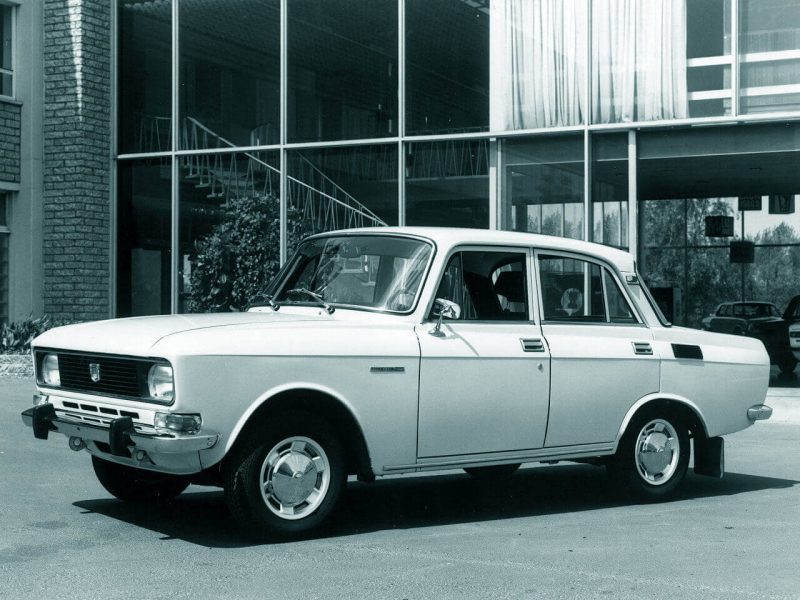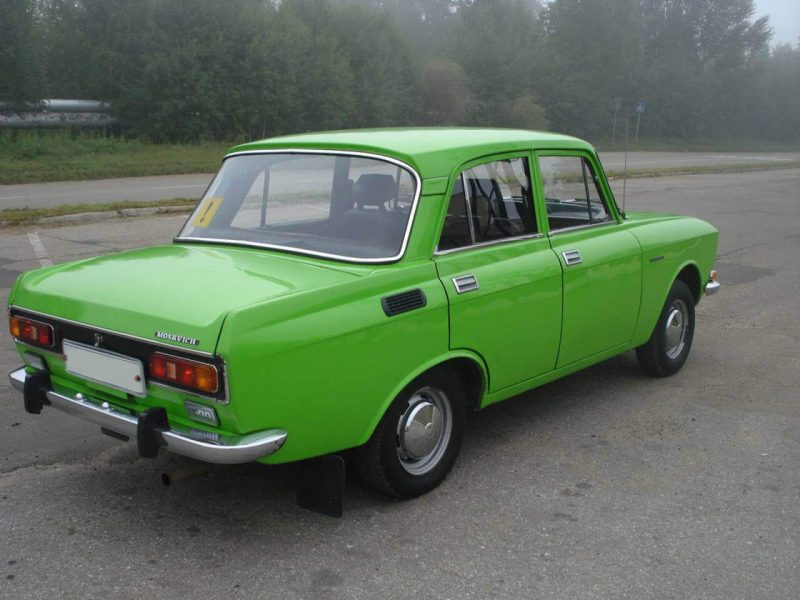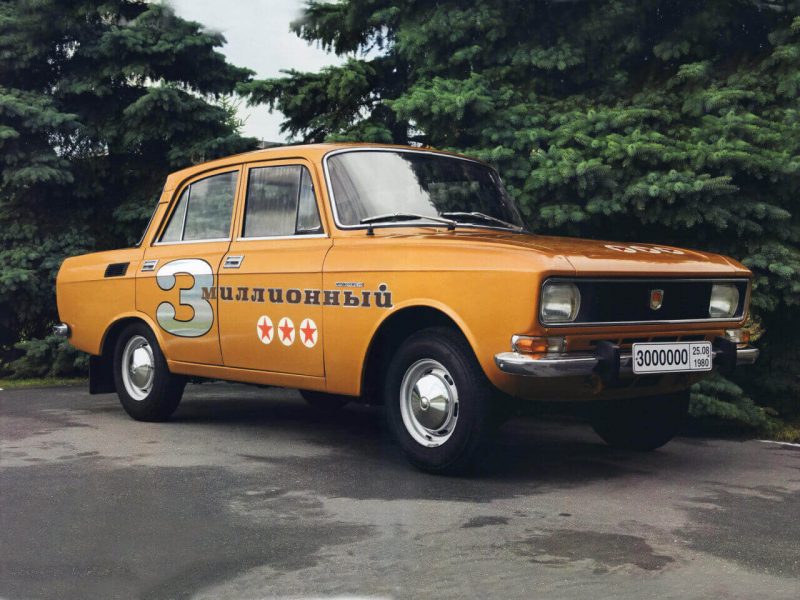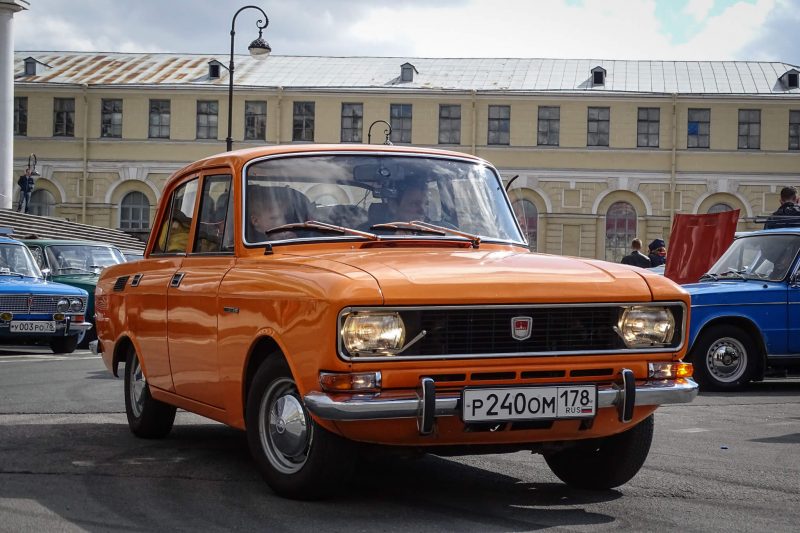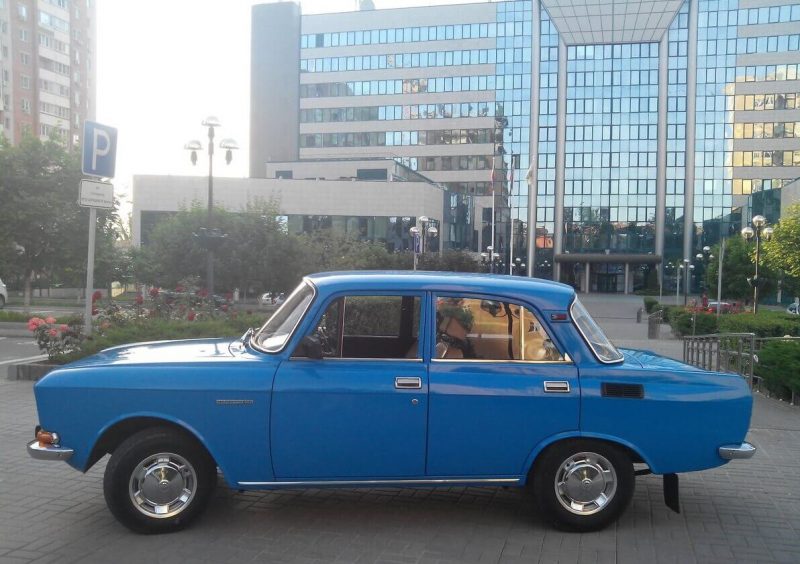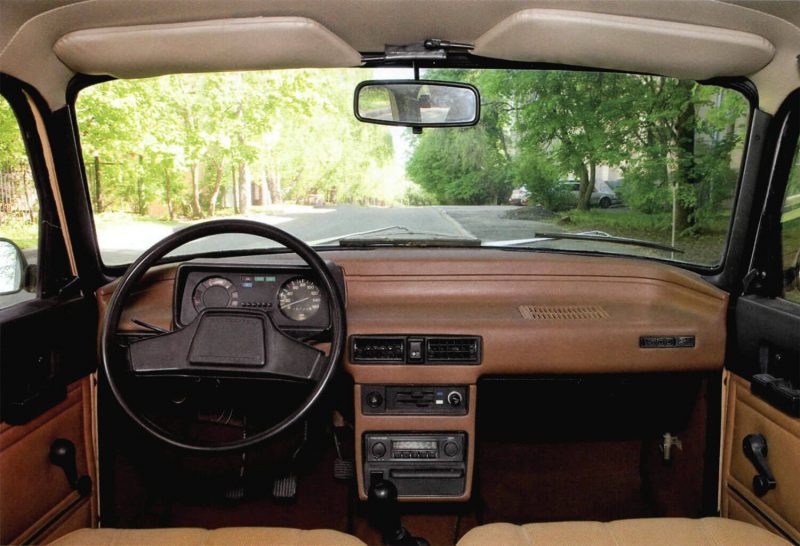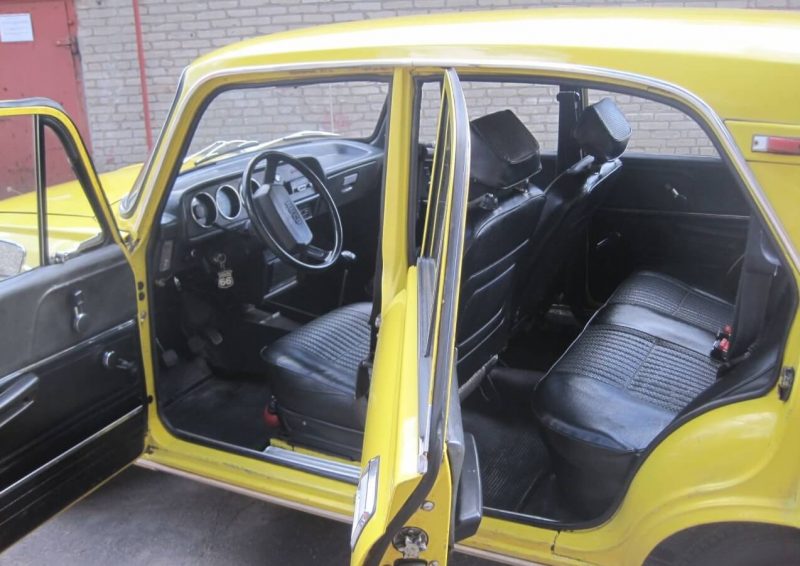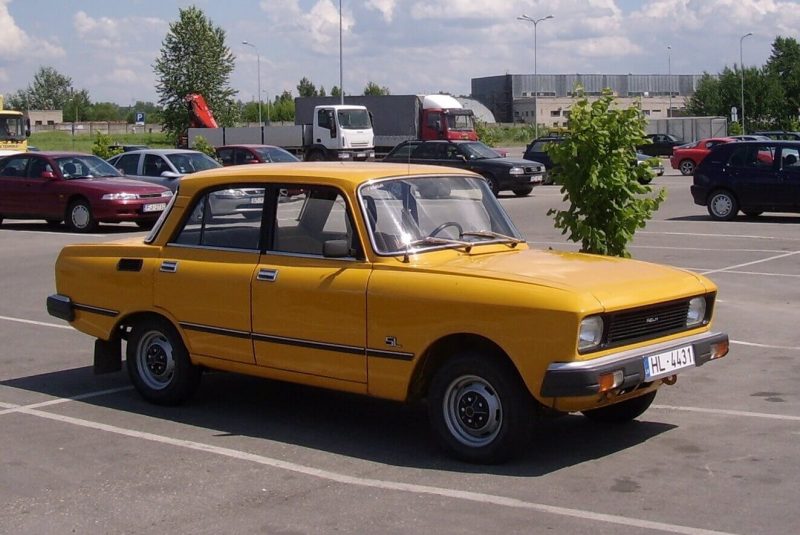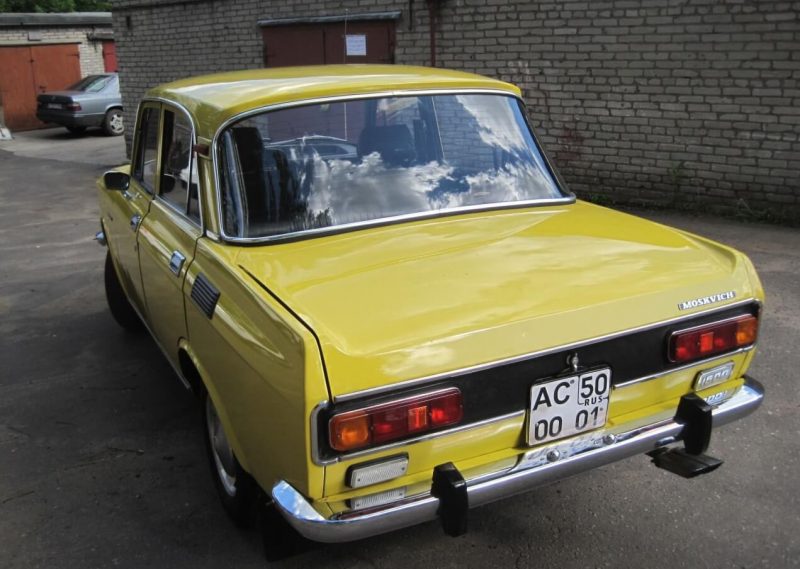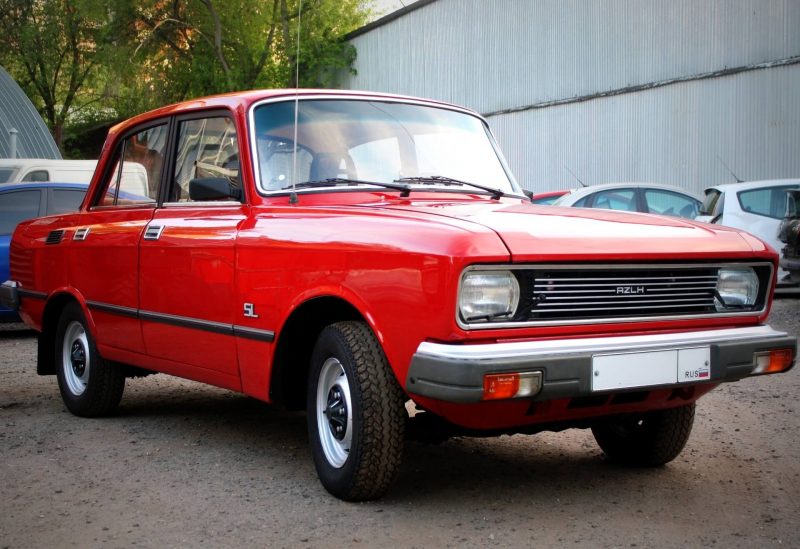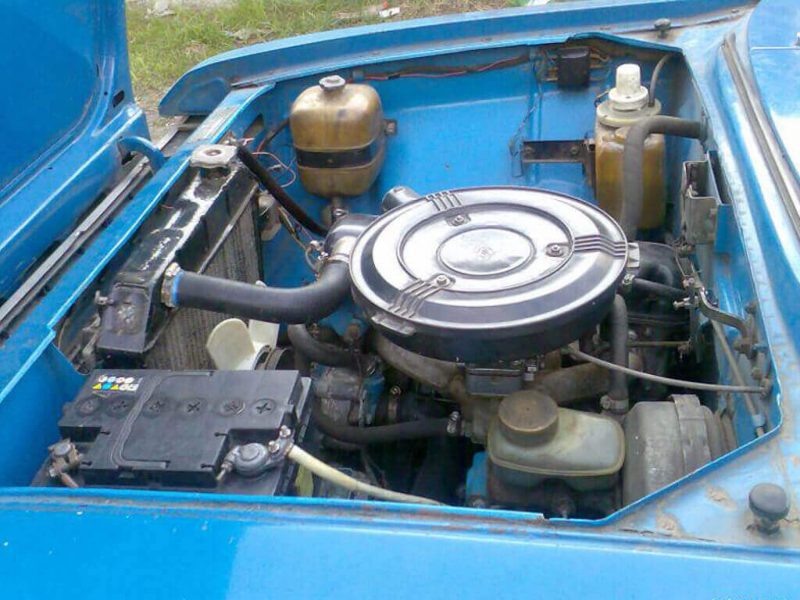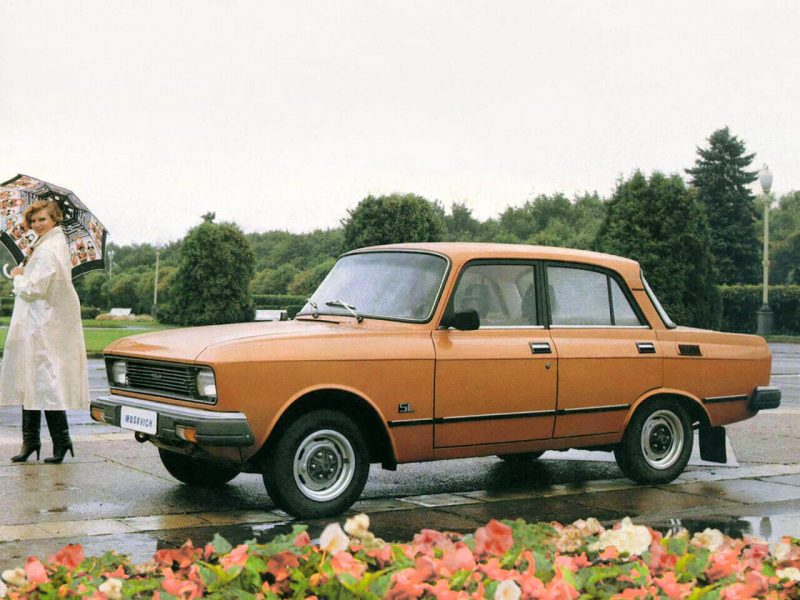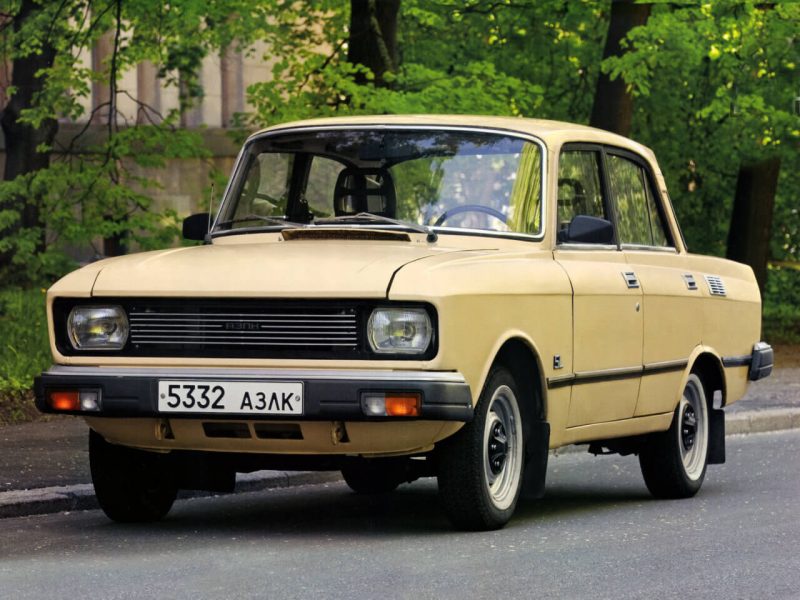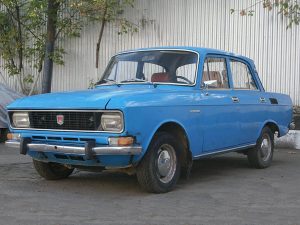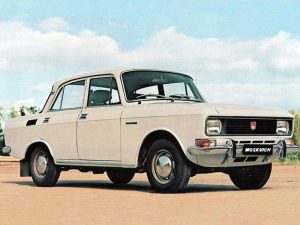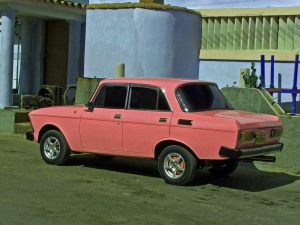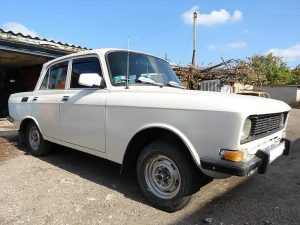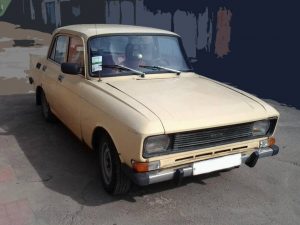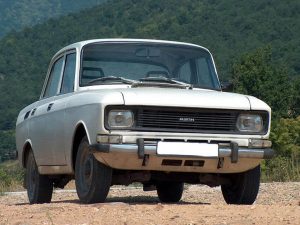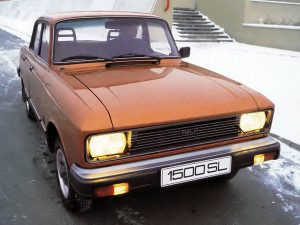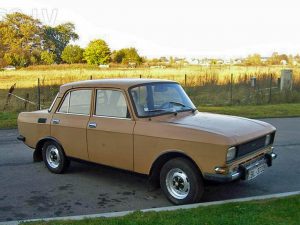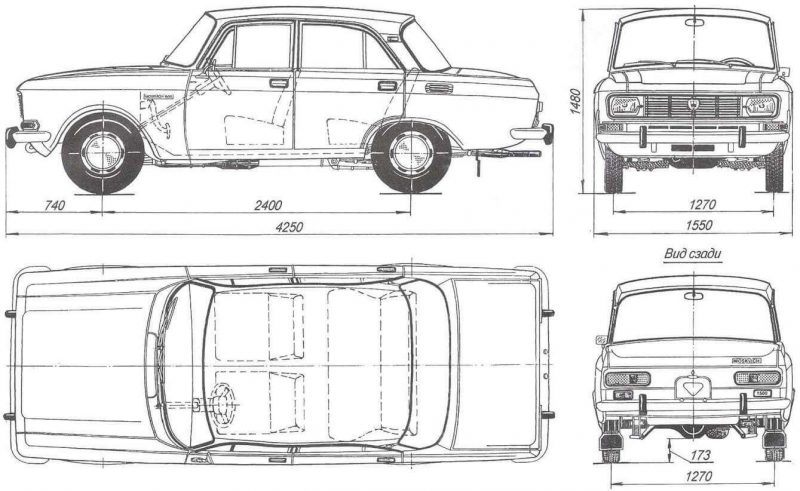Moskvich-2140
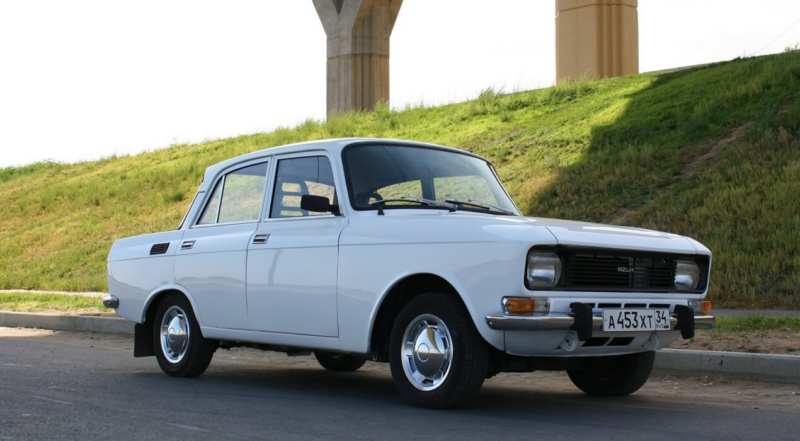
Moskvich-2140 is a Soviet small class car in a body type – a sedan. It was manufactured in series by the Lenin Komsomol Automobile Plant in the period from 1976 to 1988. The last car was manufactured by AZLK on July 8, 1988. Model 2140 represents a highly refined version of the Moskvich-412. The whole model range is Moskvich.
Car history
When the 1960s went by, in order to increase the number of produced cars in the Union of Soviet Socialist Republics up to 700-800 thousand cars per year, the Council of Ministers adopted a resolution, the provisions of which, apart from the construction of the Volga Automobile Plant and the establishment of production in Izhevsk.
It was envisaged a radical change of the MZMA enterprise, which would allow to increase the annual output of Moskvich in two or three times. During the restructuring, which lasted from 1968 to 1971, a new AZLK enterprise was built near the existing plant.
But by the time it was put into operation, the new machine could not be completed, so the production equipment decided to buy and configure for the production of 412 Muscovites. To reequip the newly built enterprise in the near future would not allow, therefore workers of factory anything remained, as next time to improve appearance, salon and minor elements of 412th Muscovite. Taking into account all this, it was important that any changes in the car did not affect the location of the main components and units, the dimension of the bottom, roof and doors.
By the end of the 1970s, the structural component of the 412th and 408th Moskvich, which at the time were on the production line, was quite outdated. The engineering staff of the enterprise was also aware of this problem. An attempt to develop a completely new car, which would be intermediate in class between Moskvich and the Volga, was recognized as unsuccessful.
The reason for this was insufficient funding and a long list of other problems. Export of AZLK vehicles went down intensively. It is clear that the Muscovites still had quite modern power units and, partially, the chassis, but there was also an outdated body together with archaic interior equipment.
Igor Konstantinovich Charnotsky, the newly appointed Chief Designer of the Automobile Plant named after Lenin Komsomol (AZLK), was personally responsible for the development of the improved car, which had a conditional index Moskvich-412. The modernization works began in 1975. Initially there was a body improvement of two generations – Moskvich-1500 and Moskvich-1360, which were the logical completion of the production of widespread and long-running cars, such as the 412th and 408th Moskvicha.
Units and assemblies for basic vehicles, except for the engine and clutch, were mounted similar. The debut versions of the serial Moskvich-412 were produced since 1976. A little later, they started to develop a modification “Lux” (SL), which was focused on the export market.
In general, it was possible to leave the structural component of the 412th model unchanged, so that the car received a more modern and better finished interior (especially in the SL version), improved appearance, which looked in the 2nd half of the 1970s, rather acceptable, more perfect and efficient system of brakes, where there were disk mechanisms on the front wheels. But if you don’t pay attention to cosmetic changes, the car kept its former body Moskvich 2140, as was the case with the previous model.
Exterior
The design staff of the company decided to replace the metal facing of the radiator with a plastic one, made in black. Small changes could not bypass the front wings, changing which, it was possible to significantly change the appearance of the sedan.
Modern appearance of the vehicle was achieved through the use of “fins”, which were located on the wings, installed at the back. This made it possible to redesign the aft part of the car, where the lanterns received a new shape and found themselves inside a chrome bezel on a black substrate.
The gap between this substrate and the rear bumper functionally justified the left-hand reversing lamp. And on the right side there is a nameplate indicating the working volume of the power unit. A considerable number of AZLK 2140 models were produced in the sedan body, however, there were also universal models, which some consider to be analogous to VAZ-2102, as such vehicles were liked by dacha owners.
If you compare the car with the 412th, the car Moskvich 2140 acquired the presence of square, fashionable at the time, headlights along with a plastic grille. Moreover, some 40s have even a headlamp cleaner. Imenno Moskvich-2140 became the first mass Soviet car, which as a separate option could be equipped with headlamp cleaners. Rear wings received a plastic grille covering the ventilation holes.
The front ones had a Moskvitch-1500 nameplate. Speaking of door handles, they were drowned. They are laconic and safe enough. It is necessary to thank the design staff, because these small innovations were enough to improve the appearance of the car to the required extent and make it more appropriate for the time. Mentioning the light alarm system, we can say that it has already received an emergency alarm system (and it is worth mentioning that it was first used on the Muscovites, and on the Zhiguli).
These stop lights, together with daytime indicators, were brighter and dimmer in the dark to avoid dazzling the drivers behind the vehicles. The “adjustment” itself to the “night” mode was carried out automatically during the switching on of external illumination.
Interior
Speaking of upgrades, it was the interior that was most affected. The updated front panel, which was moving into something like a console, began to have a fundamentally new dashboard combination, where there were large dials. Also, the modernization also affected the door lining, changed the chairs, which became more ergonomic.
The front seats were fitted with height-adjustable headrests and an anatomical cross-section profile. The backrest of the rear sofa was made wider. The final version of the improved car, which was named Moskvich-2140 in accordance with the new GOST, was ready by the middle of 1974 and was on display at the anniversary exhibition “Avtoprom-74”.
Due to the high degree of synchronization with the 412th model, it was possible to master the production in several stages. Initially (at the beginning of October-November 1975) the company produced cars with new rear fenders, facing, hood, bumpers and dashboard.
Before a month new doors and armchairs were mastered. Following this, a steering column, steering wheel, light switch and turn signals were installed. Later on, the ceiling upholstery was replaced.
There is very interesting information that in a certain period of time the company paid American specialists about 80 thousand dollars to design the interior. After it became known, our employees were very surprised, as they were able to carry out such work for more modest means.
It is worth noting that the work of American specialists were embodied only in the door maps, as the interior of the “American” production, would have raised the car in its price list, which would not allow an ordinary Soviet citizen to buy this sedan. The domestic vehicle became a debut car, which could be equipped with rear window heating as a separate option.
Of course, you can object, why was there such a need, because the designers have installed a stove, however, in the cool time the rear window is heated with such a system is much better and in a shorter time than with a single heating system of the interior.
Returning, again, compared to the “Vazovskaya kopeck”, Moskvich lost a little in the width of the salon. Luggage compartment was designed for 520 liters of useful space, which was more than that of Zhigul. However, it was allowed to carry cargo in the trunk, which did not exceed 50 kilograms in weight.
Following updates
At the beginning of the 1980s, the 2140 was undergoing the next small upgrade. Initially, the bumper was replaced by a monolithic polyurethane bumper with metal and rubber lining. Then there was a whole chain of changes – there was no chrome trim framing the radiator with headlights and the shield-shaped emblem of the automobile plant.
Instead, a small nameplate with the inscription “AZLK” or “AZLK” was installed. In addition, there was no black field between the taillights, and there were fewer company icons (for example, we decided to remove the labels on the front wings and under the rear right lantern). This modification has its own index – 2140-01.
Five years later (1985), the corners of the front and rear bumpers were made of black plastic. The shape of the decorative grille, which was mounted on the rear wings, was slightly changed – its flank sides were already slightly rounded. Typical for the 412th model, the parking lights on the upper corners of the rear window were first replaced by technical plugs, also known as “shoulder straps”.
However, a couple of years later (in 1987), they were completely removed. After the start of production of the luxury version (Moskvich-2140SL), they decided not to use the vents on the windows of the front doors, and the steering wheel designed for the car was installed on all models of Muscovites.
Moskvich-2140 Lux
The body of the export variant had almost no differences with the machines for the Soviet market. The main difference was the presence of more modern front and rear plastic bumpers, rear headlights and moldings on the doors. There are also “SL” badges, which can be found on the wings and luggage compartment lid. The radiator grille has also been slightly modified. The main difference between the export variant from the inside is the so-called low dashboard.
It had design characteristics, which were developed by the American designers on special order. But it is necessary to admit that the panel had its own big ergonomic mistakes, which led to the fact that it was repeatedly improved by Soviet specialists and engineers. As it is already known, there was an injury-free steering column, as well as the export version had an imported Yugoslavian interior upholstery. In addition, there were inertial seat belts and a gearbox steering lever.
Specifications
Powertrain
The 40th model received a gasoline 1.5-liter four-cylinder engine M-412. The Moskvich 2140 engine produced 75 horsepower and allowed to reach a speed mark of 100 kilometers in 20 seconds. The maximum speed of the vehicle is set at 140 km/h.
Such a power unit received a cylinder diameter of 82 millimeters, and the piston stroke of 70 millimeters. Such a significant advantage of the diameter over the stroke of the pistons, says about a good traction of the engine, but a more moderate speed, especially if the engine is compared with the “Zhigulevskie” engines.
92 gasoline is used. Initially, a DAAZ 2101-412 carburetor was installed on Moskvic-2140, but in the near future, it was decided to replace it with a DAAZ-2140 carburetor. Moskvich-2140 had not the best cooling system, so the engine was often overheated. Fuel consumption of Moskvich 2140 is about 11-13 liters for every 100 kilometers.
Transmission
With such a power pack it was envisaged to have a four-speed manual transmission, where there are synchronizers at all speeds, except for the rear one. The clutch is a spring-loaded, diaphragm-type clutch with a mechanical drive.
Suspension
The front wheels are equipped with an independent spring suspension, which is hingeless and has transverse levers, stabilizer of transverse stability. On the rear wheels, the Moskvich 2140 suspension has a progressive effect. It is located on longitudinal semi-elliptic springs. It turns out that there is a permanent bridge beam at the back.
Rail steering
It has a globoidal wormhole operating principle and no hydraulic power steering.
Brake system
At Moskviche-2140 it was planned to install disc brakes on the front wheels. At the back, there were the usual, drum brakes Moskvich 2140. There was a hydraulic brake drive, where there was a vacuum booster, which was separate.
Braking devices of the rear wheels, received mechanisms to maintain a constant gap between the pads and the drum, in automatic order. The actuator has a pressure regulator mounted.
| Body type | Sedan |
| Number of doors | 4 |
| Number of seats | 5 |
| Dimensions, weight, volume | |
| Length | 4250 mm |
| Width | 1550 mm |
| High | 1480 mm |
| Wheelbase | 2400 mm |
| Retails of wheels, front/back | 1270/1270 mm |
| Clierence | 173 mm |
| Concentrated mass | 1045 kg |
| Tank volume | 46 l |
| Engine | |
| Motor position | Forward, longitudinally |
| Working volume | 1479 cm3 |
| Cylinder number | 4 |
| Cylinder layout | Sequential |
| Number of valves per cylinder | 2 |
| Power system | Carburetor |
| Power | 75 at 5800 hp at rpm |
| Torque | 108 at 3800 N-m at rpm |
| Fuel consumption | |
| Average fuel consumption | 10.2 l/100 km |
| Fuel consumption in the city | 10.3 l/100 km |
| Fuel consumption on the highway | 7.4 l/100 km |
| Fuel type and brand | AI-92 Petrol |
| Transmission | |
| Drive type | Rear |
| Box type | ICPP |
| Moving part | |
| Forward suspension | Double wishbone |
| Rear suspension | Non-removal bridge beam |
| Brakes front | Disc |
| Rear brakes | Drum |
| Tires, standard equipment | 165/80R13 |
| Dynamic characteristics | |
| Razgon from a place up to 100 km/h | 19.0 with |
| Maximum speed | 142 km/h |
Car modifications
| Moskvich-2140 | is the base sedan of “1500” division. The model was produced from 1976 to 1988. |
| Moskvich-2140-01 | the result of the 82nd year, a small modernization. This included the removal of front door windows, modified bumper design, simplified bodywork, removal of chrome moldings and nameplates, the addition of chrome grilles and the installation of an armrest. Moreover, the massive factory badge in the form of a shield on the grille has been replaced by a simple name “AZLK”. |
| Moskvich-2140D | is a modification of the sedan, where there was a deformed engine for 76th gasoline. Very scarce car, as there was a relatively small price and high prevalence of gasoline A-76. |
| Moskvich-214006 (214007) | serves as an export modification. |
| Moskvich-2140-117 | represents “Lux” set. The Soviet vehicle received a new “low” dashboard and other interior decoration, which was produced by the Yugoslav company “Saturnus”. There was also the presence of new rear lights, wider plastic bumpers (which were similar in size to the installed European models for Americans), where there were chrome overlays, along with moldings. The latter, by the way, were also the production of Yugoslavia. Some machines of this model, for the first time in the USSR, began to paint in “metallic”. |
| Moskvich-21406(7)-117 | represents “Lux” version – export modification. |
| Moskvich-2140-121 | Machine served as a taxi, where there was a deformed power unit for 76th gasoline, taximeter and leather upholstery. The car was produced since 1982 under 1987. |
| Moskvich-21403 | is a modification for manual control (for disabled people), where there was a motor UZAM-412D. Manual brake and clutch levers were located on both sides of the steering wheel. All this led to the need to let the steering wheel out of the hands to push them simultaneously. They began producing a modification from 1979 to 1987. |
| Moskvich-21406 | model for rural areas, which had deformed power unit UZAM-412D (68th horsepower), and which worked on low octane 76th gasoline. There were drum brakes on all wheels, which allowed the use of BSC brake fluid, which was not so scarce in the province as “Neva”, also put a reinforced spring suspension and towing eyelets. A little later, the Soviet vehicle also came with front disc brakes. If to speak for appearance, the sedan was retailed by the lack of decorative caps on wheels. The car was produced from 1978 to 1987. |
| Moskvich-21401 | this modification was used by medical services. Muscovite-21402 – right-handed export version. Model M-214026 was for moderate climate, and M-214027 for tropical climate. |
| Moskvich-2315 | serves as a commercial modification in the back of a pickup truck, which was assembled in a small number of copies from 1984 to 1988 on the platform of defective sedan and wagon bodies. |
| Moskvich-2137 | is the basic universal of the “1500” unit, where the power unit UZAM-412 stood. Produced a car from 1976 to 1985. |
| Moskvich 2734 | is a commercial van, where the power unit UZAM-412 is installed. The car was produced from 1976 to 1981. |
| Moskvich-2733 | serves as a commercial van with M-408 engine. Made a vehicle from 1976 to 1981. |
| Moskvich-2138 | is a base sedan with M-408 motor. Produced a car in the period from 1976 to 1981. |
| Moskvich-21381 | represents a modification for medical services. Production lasted for 7 years, until 1981. |
| Moskvich-2136 | version of the universal with powertrain M-408. Modification of the serial version of the universal was not made, so only the only experimental model of this type was made. |
| Moskvich 1600 Rallye | the car is a rally modification, which was homologated in 1976 in the international group 2, class 8 (up to 1 600 cubic centimeters). The main difference from the standard modification is the forced power unit 412-2V (412G), where was a twin-shaft eight-valve GBTs, the volume of which is 1.6-liter. The truck has 130 horsepower, and there is a completely different gearbox KP-9 or KP-10. Stasis Brundza in 76th took part in the Finnish rally “1000 lakes”, but he could not finish because of the accident. |
| AZLK 1600 SL RALLYE | represents a rally modification, which was homologated in the 83rd in the international group A6 (up to 1 600 cubic centimeters). The car differed from the standard sedan, the presence of a forced 1.6-liter engine, which produced 145 horses (used dual carburetors Weber 45DCOE), gearboxes KP-9, two shock absorbers for each wheel, front disc brakes, where there were four-piston calipers, front and rear stabilizers of transverse stability. Also, the rear axle had a parallelogram of Watt. On this modification, domestic drivers participated in foreign competitions more than once, for example, in the rally Yugoslavia “Saturnus”, and they managed to hire places in the 1st ten finishers. |
Stability
It is clear that it will not be possible to buy a new Soviet sedan, but there is an option to buy a used car, which, by the way, will be cheaper than Zhiguli. The value of the vehicle Moskvich-2140 in normal condition, can rarely exceed 1,500 dollars. About Moskvich 2140 reviews are of course different, but many say that he is a real worker. The cooling system is also often subject to poor feedback.
Pluses and minuses
Pluses cars
- Good bodywork;
- Low pricing policy;
- Pleasant and stylish appearance;
- Reinforced power units;
- Appceptable ground clearance height;
- Mounting the front disc brakes;
- Little volume of luggage compartment;
- Comfortable seats with headrests;
- Improved dynamic characteristics;
- Large number of modifications, including rally versions;
- Not afraid of overloading, thanks to the rear axle on the leaf springs;
- Improved dashboard;
- Not bad visibility;
- Become a more pleasant salon;
- Some modifications had headlight wipers;
- Set the fuser and the rear window heating function;
- Traumatically safe front panel;
- Pleasant interior decoration.
Cons of a car
- No hydraulic power steering;
- No hydraulic power steering
- Low fuel consumption;
- Not very comfortable luggage compartment;
- As compared to “Zhigul”, Moskvich has a cramped salon.
We sum up
To date, AZLK and VAZ cars are purchased by novice drivers who simply do not have the funds for another car, or connoisseurs of rare vehicles, what kind of restoration or tuning Moskvich 2140. Some of these vehicles are inherited and family members have no need to sell them. It is clear that there is no sense in recommending buying this car, because the car is old, and it will require a lot of care.
Moreover, the car eats a lot of gasoline. But if we take the years when the model was just released, it was a great option, and not only in the domestic market, but also abroad. The sedan had a modified appearance, front disc brakes, which increased safety and required less braking distance.
Many motorists liked the model because of the fact that there was a large trunk which allowed to carry a sufficient amount of cargo. Moreover, Moskvich is not afraid of overloads, so even today it is often used in the transportation of, for example, vegetables and fruits, loading on the roof.
Inside is also nice to be, as they began to use more leatherette substitute, as well as made an injury-free front panel. In general, Moskvich-2140 is the first car of the Soviet production, which passed international crash-tests. Therefore, the car was used not only within the country, but also outside the Soviet Union. In fact, Moskvich-2140 became a separate page in the Soviet car industry.
We advise you to read the article: “History of the car “Moskvich” and AZLK enterprises


